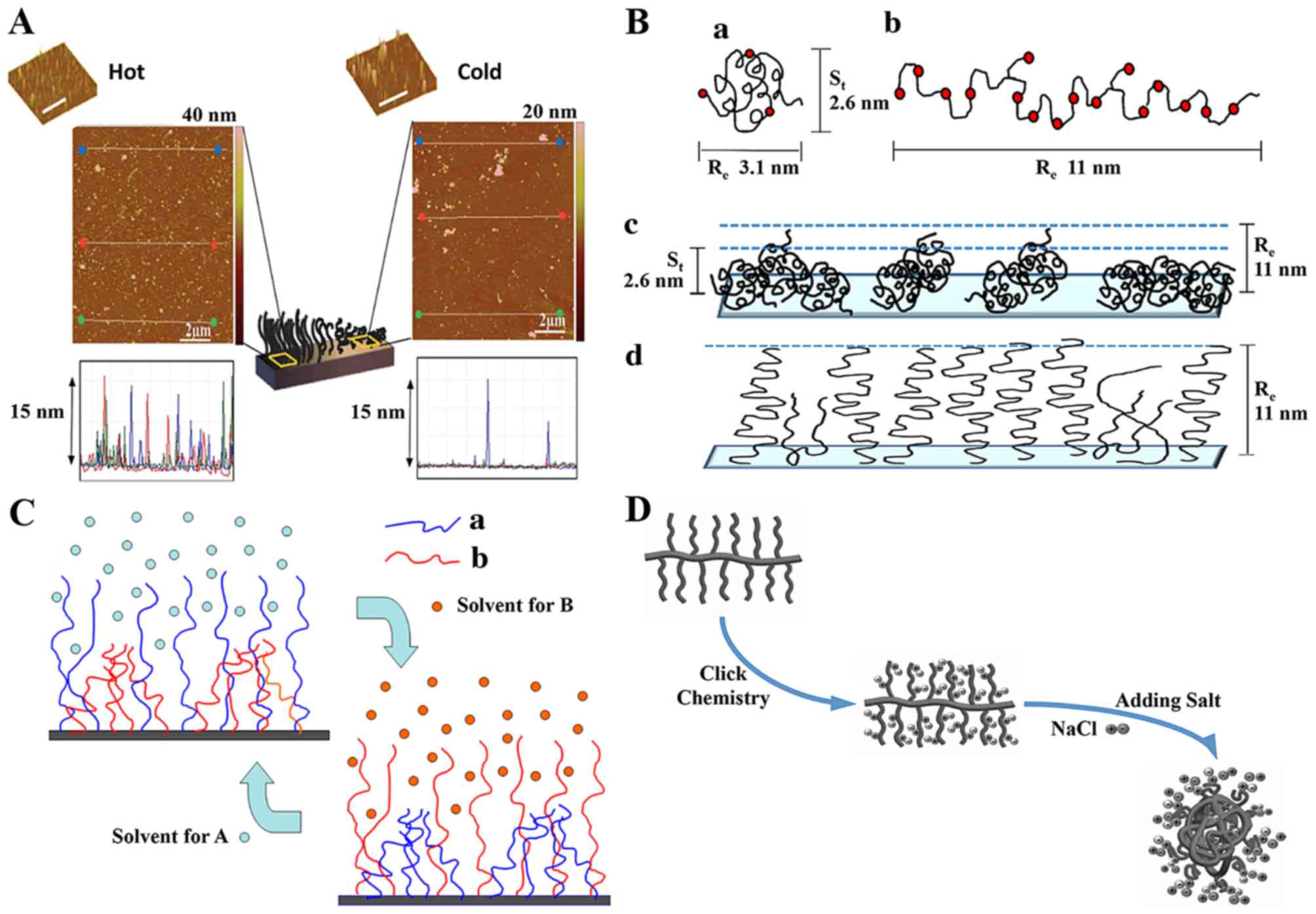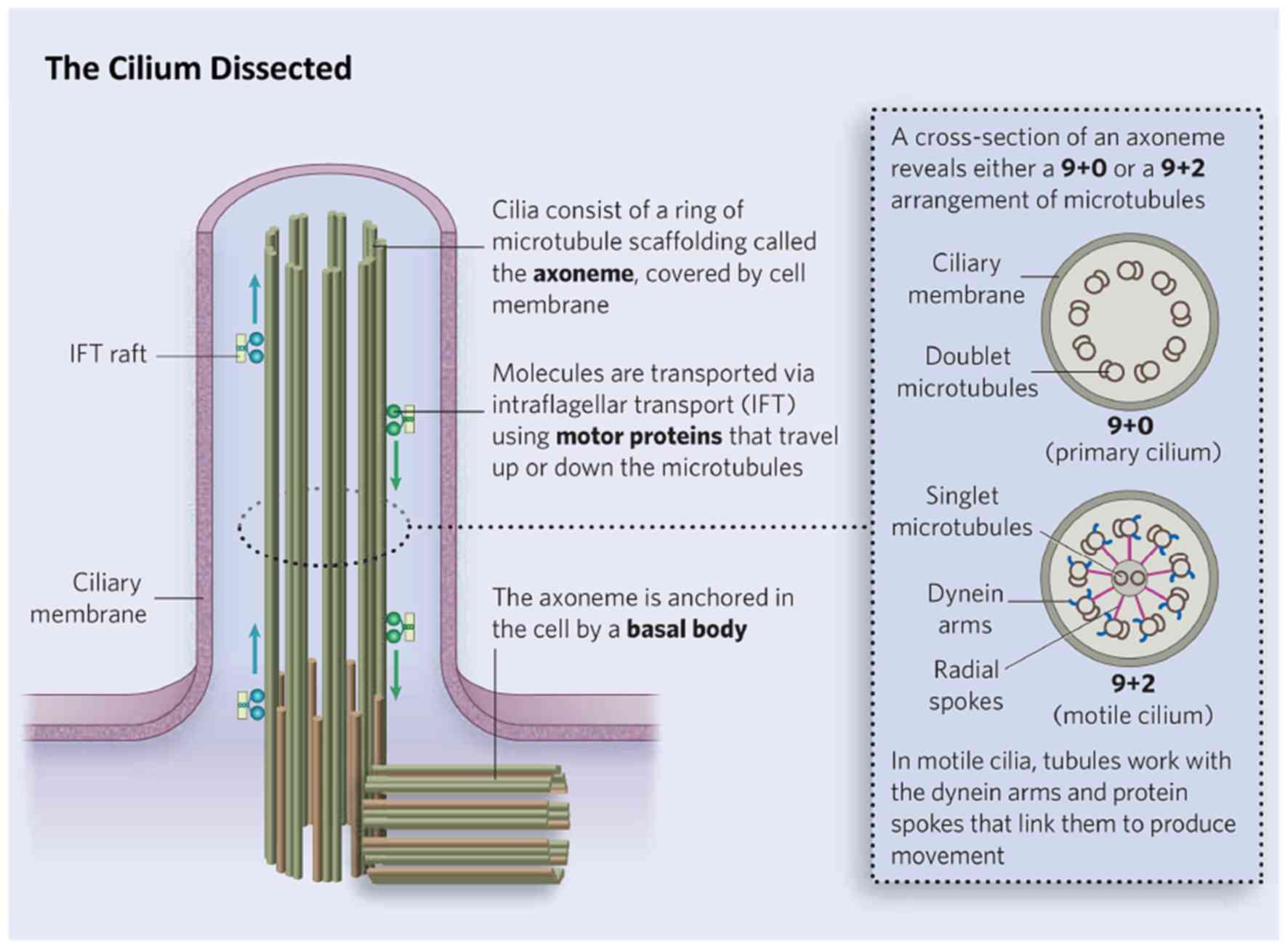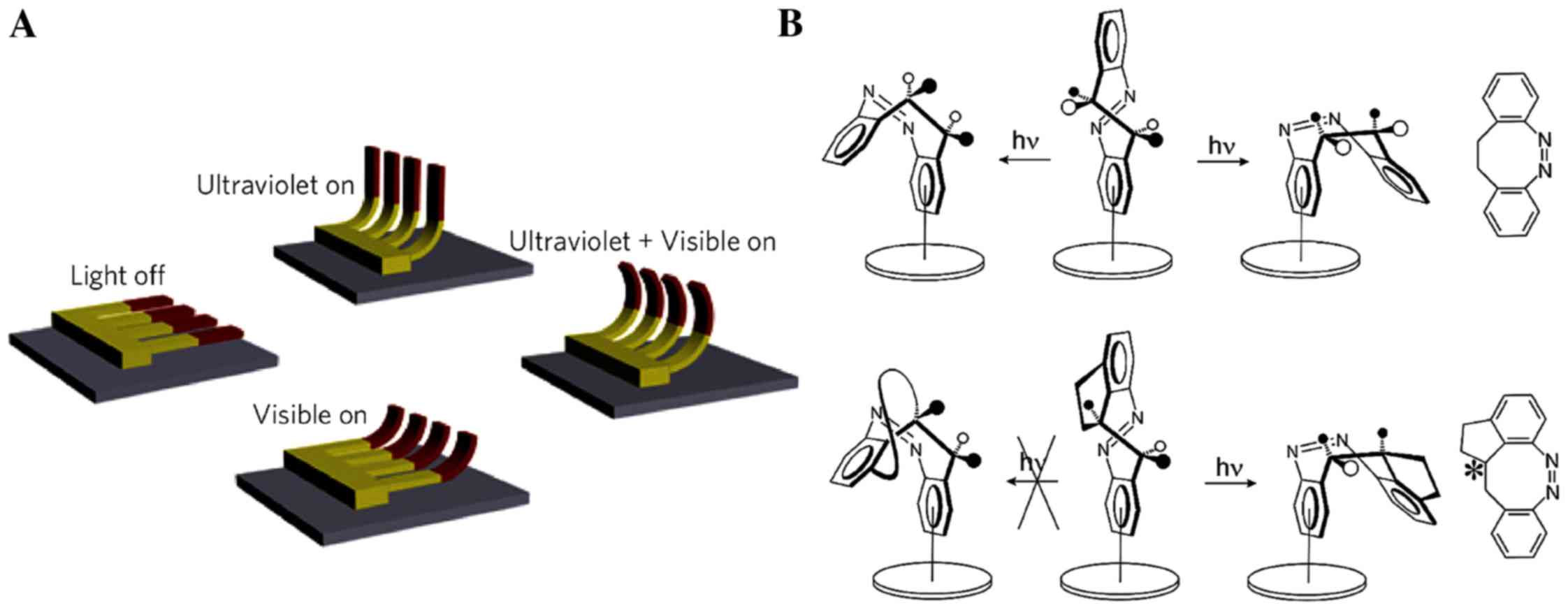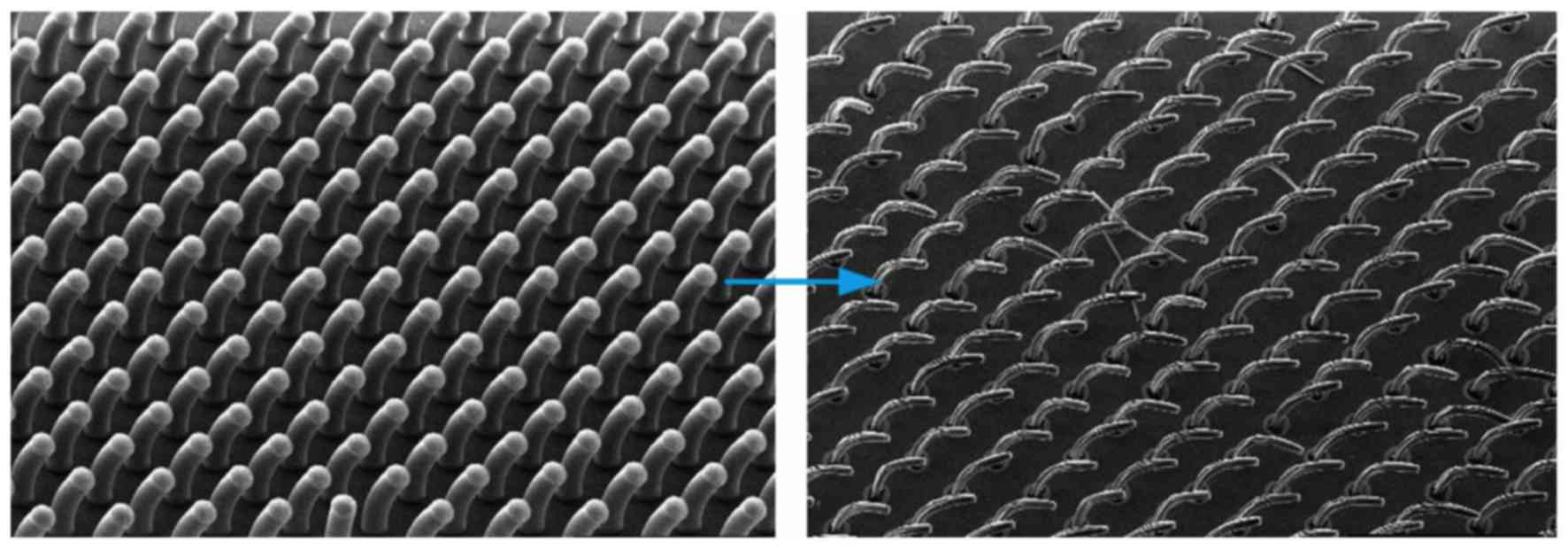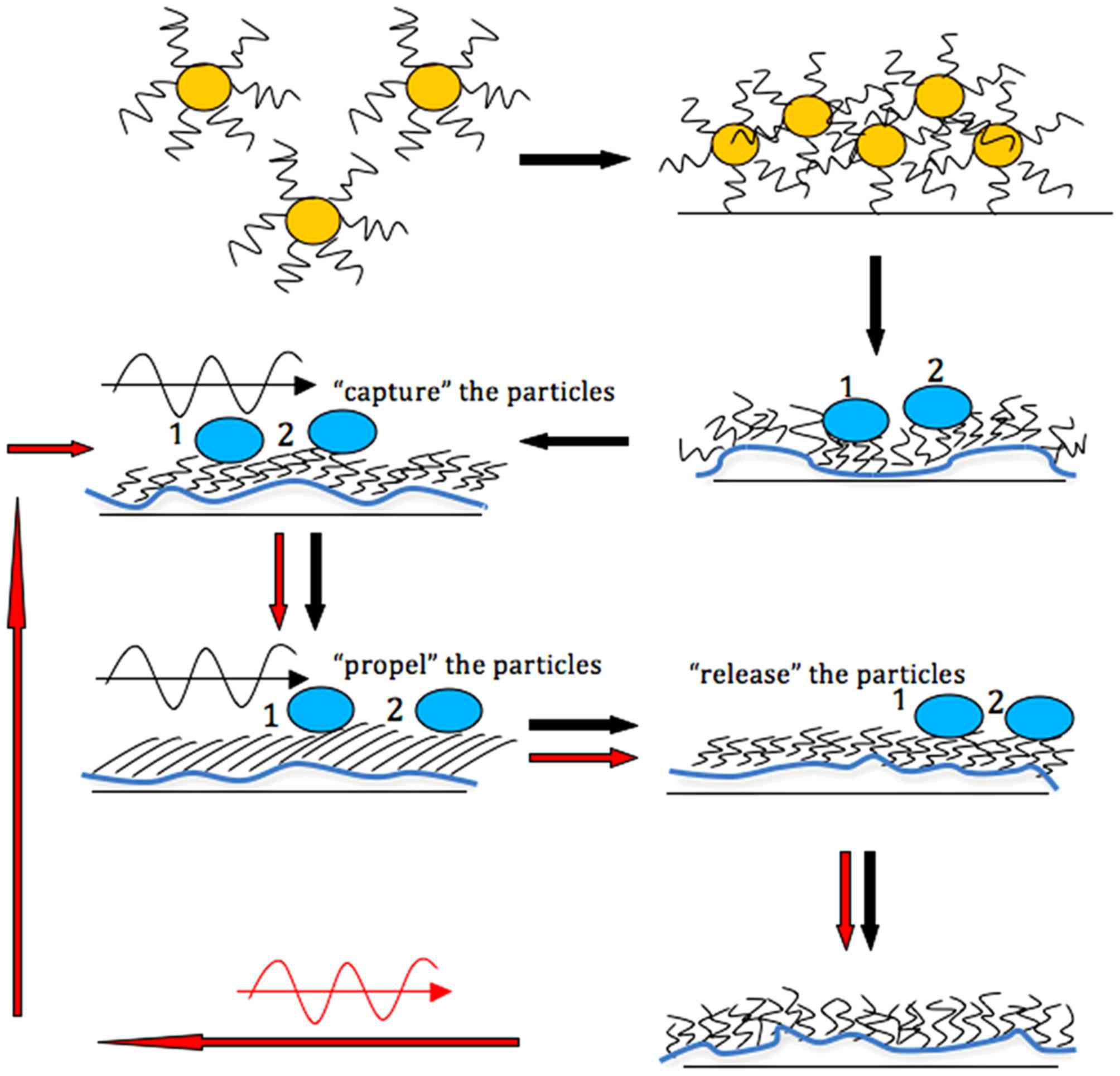Introduction
Artificial trachea, a replacement procedure
following tracheal overcut to repair tracheal defects (1), has overcome many complications
frequent in earlier clinical trials (2), and exhibits great biocompatibility
and structural stability (3).
However, studies report that artificial trachea is linked to severe
infections and restenosis due to the lack of cilia; the airway
waste is accumulated on the nude inner surface of the trachea where
bacteria thrives, and the smooth inner surface of the trachea
causes the surrounding tissues to grow inwards (4). To solve this issue, researchers have
experimented with various parameters, for instance, altering the
design of the internal diameter of transplants (5), as well as altering the surrounding
microenvironment with anti-inflammatory factors (6). However, these findings require
further validation. Recent developments in biomedical engineering
and polymer science, including using polymer brushes as a method
for surface modification, has led to further investigation into
tracheal re-epithelization. Combining the preparation and molding
technology of polymer materials with artificial cilia research, it
is possible to produce a cilia-like film to coat the inner surface
of a reconstructed airway to replace the natural damaged cilia, in
order to remove airway waste. This strategy represents a
potentially positive clinical application in the field of
artificial cilia research.
Properties and research of stimulus-response
polymer brushes
A polymer brush is a polymer system consisting of a
high density of short chains grafted onto a surface to form a
special topological structure, which appears as a stretched
conformation. It resembles a brush between the short and main
chains, influenced by a steric effect. Along with the rapid
development of polymer science, the structure and length of polymer
brush molecules may be controlled precisely; therefore, it presents
an attractive applicability in many fields, including drug delivery
(7,8), lubrication (9,10),
altering the conductivity of a material's surface (11,12),
and controlling the transport of small particles (13,14).
In recent years, investigation into the stimulus-response polymer
brush has involved biochemical, environmental biology and
biomedical applications. This is owing to its ability to reversibly
switch between adaptation and responsiveness via external
stimulation, including temperature (15–17),
pH value (18), ionic strength of
the solvent (19,20) and light (21). A schematic diagram of polymer
brushes is shown in Fig. 1.
Temperature-responsive polymer
brushes
Temperature-responsive polymer brushes (17) can be divided into two types
according to their functional groups: lower critical solution
temperature (LCST) or upper critical solution temperature (UCST)
group, including the polymers PNIPAM, PDMAEMA, PMEMA and PPO. Among
them, PNIPAM is a typical temperature-sensitive polymer that is
most frequently studied, and its height gradually as temperature
increases. The responsiveness of temperature-responsive polymer
brushes is affected by additional factors, including molecular
weight and hydrophobicity of the monomer.
pH-responsive polymer brushes
The height of pH-responsive polymer brushes
(18) alters with environmental pH
value, leading to the receipt or release of protons due to the
ionizable groups in some polymers, including PAA, PMA, PDMAEMA and
P4VP. This response relies on different properties of polymers; for
example, the electrostatic repulsion between polymer chains or an
alteration of solubility.
Solvent-responsive polymer
brushes
Block polymer brushes or mixed polymer brushes are
used to manufacture solvent-responsive polymer brushes (19) generally, and a morphological
alteration is produced via phase separation to varying degrees in
different solvents. This is common for the polymers PMMA, PBMA and
PS. The morphological alteration of the polymer brush is obtained
by altering the wettability through solvents; however, it may be
influenced by other factors, including the relative length of all
the blocks in the polymer chain.
Ionic strength-responsive polymer
brushes
The ionic strength (20) is controlled to directly affect the
electrostatic repulsion and steric effects of the polymer brush,
and then the inner osmotic pressure and elasticity of molecular
chain structure are affected immediately to alter the morphology of
brushes. It has been demonstrated that the response of ionic
strength-responsive polymer brushes is influenced by the
concentration of salt (21), ionic
radius (22) and the structure of
the molecular chain (23).
Currently, polymer brushes are primarily used for
surface modification, including alterations in wettability,
permeability, absorbability and adhesion in other materials due to
its unique topological structure (24). The modification ability is based on
the strong electronic repulsion, entropic stretching costs and
restricted constraints for irreversible grafting (25). For monomer polymer brush, the
responsive activity relies on the density of grafts and the
property of its functional groups, but for block polymer brush, the
responsive activity relies on phase separation of different blocks
and response to the relative reagent (26).
However, in the biological application of polymer
brushes, there is a requirement to focus on the obtained
conformation response by external stimuli and the controllability
of the property of the material itself, as it is necessary to
consider the long-term stabilization (physical and chemical) of the
polymer material in vivo. The complicated environment of an
organism renders it vital to develop a responsive system to control
multiple stimuli efficiently.
Structure and function of natural cilia and
current research of artificial cilia
Cilia is a type of hair-like organelle based on
microtubule structures. Cilia are critical for movements of liquid
through the body, but may also function as a cell receptor
(27). They serve an important
role in mediating bodily functions, alongside other hair-like
structures. For example, the atrophy and loss of olfactory hairs on
the top of nasopharyngeal epithelial tissue may cause anosphrasia
(28). Auditory hairs serve a
pivotal role in allowing a rapid hearing response to the vibration
signals of sound waves, and grow on the inner ear hair cells; the
microvilli of intestinal mucosal epithelia cells are an important
structure for the body to assimilate nutrients; the fertilization
process of sperms and eggs may only be accomplished with the help
of the cilia in the human genital tract (29). Previous research has demonstrated
that whether the cilia have motor activity primarily depends on the
differences in ciliary axonemes (29). The ciliary structure is presented
in Fig. 2 (30).
The present review primarily focused on active
cilia. The cilia in airways eliminate waste via asymmetric and
periodic bends to keep the airway clean and smooth. The movement of
natural cilia uses the ATP stored in the cell body as energy to
fuel the function of axonemal dynein. Previous studies indicated
that, due to its small size, the Reynolds number of ciliary beat is
less than 10−2, which conforms to the low Reynolds
number conditions (31,32). Therefore, the inertial effects are
not significant and the flow relies on the liquid viscosity
more.
Based on the structure and function of natural
cilia, studies on artificial cilia have seen a rapid development in
the last decade, especially in the field of lab-on-chip devices.
Usually, these cilia are made of polymer materials prior to
modification, and are used to manipulate fluid flow under certain
external stimuli, including electrical (33,34),
magnetic (32,35–37),
light (38,39), pH (40–42)
and temperature (43,44). Overall, these developments of
artificial cilia are closely associated with polymer science
research, because polymers may be easily modified to functional
material. Combined with proper design and assembly, polymers may
reach adaptive responses easily for environmental temperature,
humidity, atmosphere and micro stress. One of the first examples of
artificial cilia to control fluid flow was an electric-actuated
cilium (33). From a practical
point of view, the electric-actuated cilia had three main
limitations. The relatively high electric field extends into the
fluid domain and therefore electro hydrodynamic effects may occur,
which potentially leads to electrolysis. In addition, the principle
did not work in conductive fluids, including certain biological
fluids, because the electrical field may damage biological
components of cells. Therefore, magnetic-actuated cilia have been
developed to overcome these three primary limitations, and have
become the most studied artificial cilia (45–47).
They are made from a polymer matrix film consisting of embedded
magnetic nanoparticles in response to the external magnetic field
(48). In addition, other
magnetic-actuated cilia have been synthesized using self-assembling
super paramagnetic beads in an external magnetic field (32). Novel studies involving artificial
cilia are introduced as follows.
Light-actuated cilia
Light-actuated artificial cilia (Fig. 3), have been developed from a
polymer material consisting of light-activated chemical groups that
may alter their conformation reversibly under different wavelengths
of light, in order to simulate the oscillation motion of cilia
(38).
A new study from the University of Kiel (Kiel,
Germany) demonstrated that new light sensitive artificial cilia
have been developed to mount azobenzenes onto the cell membrane
(39). The artificial cilia
exhibited directional movement. The accomplished progress of this
motion occurred via special surface-containing cilia molecules,
which concluded that a type molecular suction cup was being used to
control the switch. This molecular suction cup may be adsorbed on
the gold surface (49)
successfully and maintains a flow state to attract the cilia
molecules constantly following the complete self-assembly of cilia
on the surface under light. Symmetric diazocines as well as
asymmetric molecules were controlled to alter the directional
motion of cilia (39). This study
facilitated the understanding of artificial cilia, which as
biological transport systems, are important in self-cleaning, thus
providing a potential novel strategy for the treatment of diseases
such as primary ciliary dyskinesia.
Force-actuated cilia
Force-actuated cilia are less widely researched
because it is difficult to control cilium-directed motion; however,
this kind of active cilia will potentially become the main type to
be used in the engineering of artificial cilia in the future.
In previous years, researchers have provided novel
ideas to solve the manufacturing problems of artificial cilia
engineered mimicry, with increasing numbers of studies discussing
carbon nanotubes (CNTs). A novel technique has been presented for
scalable fabrication of freeform microstructures via
stain-engineered growth of aligned CNTs (50). This method represents a versatile
principle for designing and manufacturing complex microstructured
surfaces, as shown in Fig. 4. Four
important problems surrounding CNTs require solving. Firstly,
modulation of local CNT growth rate using offset patterning of the
CNT growth catalyst. Secondly, confirmation of the final shape of
curved CNT microstructures, designed via finite element modeling.
Thirdly, overcoming the production of microstructures with
multidirectional curvature and unusual self-organized patterns.
Finally, the tuning of the mechanical properties independent from
the microstructure geometry, by conformally coating CNTs.
In conclusion, the field of artificial cilia in
bionic biology is still a relatively young field, and their
implementation in commercial products is still rare. Nature has
proven that the artificial cilia may be able to work in complex
biological applications, due to their fluid manipulation
effectiveness, their ability to locally control flows and the
elegance of potential full integration, making them worthy for
further investigation.
Application of polymer brushes in the field
of artificial cilia
Polymer brushes have a similar topological structure
to natural cilia. Although some size diversity exists, polymer
brushes have had good applications in the field of surface
modification, and additionally have various functions, including
the delivery of medicine and genes (51,52),
enzyme biosynthesis (53,54) and use in culture medium (55,56).
A recent study on artificial polymer brushes involved an artificial
biological transportation system, as well as other research on a
functional artificial epithelium, by applying an external stimulus
on the carried nanoparticles to determine the effect of the brush
as artificial nasal mucosa (39).
Taken together, research into polymer brushes and cilia suggests
that by combining polymer brushes and artificial cilium, a polymer
net-structured material may be developed to imitate morphology and
functionality of the natural cilium system. Proper design of the
high polymer material and suitable polymer molding technology would
be required. To achieve this design, the micromechanics of the
polymer must be studied thoroughly.
At present, a polymer brush is treated as a fluid;
thus, the rheology of polymer brushes is critical. This study of
polymer brush rheology dates back to the 1950s (57), with discernable breakthroughs being
been made in the 1970s (58). For
polymer brushes, plenty of more recent studies point to polymer
brush emulsion as a measure of its stability and rheological
properties, based on Russel's (59) research, to develop the flow
properties with polystyrene emulsion. These studies on the
mechanical properties of the polymer revealed that the rheology is
an important method in the characterization of these properties.
Emulsion rheology has been extensively studied; however, there are
limited studies on polymer brush film during the period of
simulation. The main research has focused on variations of
viscosity between each polymer brush layer under steady and
oscillatory shear force. Alexander (60) conducted research on the absorption
function of a flat sheet membrane with results demonstrating that
stretching forms from free energy balance. On the basis of the free
energy theory and experiment data, high-density polymer chains from
the same layer overlap vertically, which may enhance the contact
and interaction energy among chains. Polymer chains would be forced
to stretch vertically from nodes, leading to a polymer density
decrease, while the polymer brush thickness increases. Therefore,
when solvents exist in a polymer brush system, the polymer brush
stretches in order to obtain a larger contact area. On the other
hand, when solvents do not exist in the system, polymer brushes
stretch from the interface to avoid overlapping in the limited
space. de Gennes (61) and
Halperin et al (62)
experimented on the self-assembly of the stratiform copolymer and
its effect on the polymer chain, based on the model made by
Alexander (60). They simulated
the inner structure of the polymer brush based on their experiment
data.
From the aspect of dynamics, mathematic models and
calculations have been made to simulate the deformation of brush
layers under force. Based on recent studies (63,64),
a few demonstrated that polymer brush layers incline when applied
with shear force, but they are not sensitive to the magnitude of
shear force. This property was observed particularly in the polymer
brushes with nanoparticles embedded; their entropy stability makes
it possible to maintain a stable performance under high shear
force. Common research methods include the self-consistent field
theory, the particle model and the coarse-grained model (24,62,65).
However, those methods may be only applied to a single component
system; application to multiple component systems remains to be
developed. As for a stimulus-response polymer brush, density
functional theory is widely used to describe the structure
deformation. Research has demonstrated that this may predict the
thermodynamic and structural properties (24). In particular, description of a
system's structural deformation prior to and following a stimulus
made by dissipative particle dynamics would be vital to its
practical use as well.
However, with its excellent ability of surface
modification, polymer brush material following processing is
applied in the field of biology as a kind of artificial cilia with
a similar topology and suitable mechanical requirements in specific
applications. For example, polymer brushes would be subject to
constant shearing and washing in the inner face of the artificial
trachea, brought about by airflow and mucus. This means that the
polymer brush film must meet the shear test under certain
conditions, so that the brush layer does not come off, flocculate
or clump at a sufficient shear force. At the same time, the
components of the mucus differ depending on the health and
pathological states of the patient. Therefore, stretching side
chains on the polymer brush film are required to be able to move
various fluid environments.
Thus, it was hypothesized that the selection of
appropriate monomers to create a polymer brush, as well as the
coating material, with a similar ciliated topology, may be molded
to help the artificial tracheal substitutes clear away airway
wastes. The process is presented in Fig. 5. After shaping a cilia-like film
layer, certain side chains of the polymer brush materials are
adhesive to the base, and another part of the side chains
intertwine with each other to form a film. Due to the steric
hindrance, the rest of the side chains will extend into space
freely. Meanwhile, the extending side chains of brush polymers end
with a charge or some other features, including thermal, pH or any
others in solution that will be able to generate electrostatic
repulsion. Therefore, the spatial structure of the side chains is
more extended, and may lead to increases in the height of the
polymer film cilia-like layer. In addition, it may present many
different properties when interacting with mucus.
In conclusion, progress has been made regarding
using polymer brushes as a type of a surface modification of the
epithelium following airway reconstruction, although further
studies are required. Combined with the technology of polymer
shaping, as well as making use of the advantages of polymer brushes
to alter surface properties of the materials effectively, future
studies may investigate coating films on the inner surface of
reconstructed airways, which is produced with polymer brush
material. These films may have similar topology to the natural
epithelium and effectively replace the airway epithelial layer to
clear away waste mucus. This has profound significance for the
reconstruction of artificial trachea and the treatment of the
tracheal defects.
Acknowledgements
This review was supported by the National Science
Foundation of China (grant no. 31400805), the Chongqing Natural
Science Foundation (grant no. cstc2012jjA10069) and the Fundamental
Research Funds for the Central Universities (grant no.
CQDXWL-2013-026).
References
|
1
|
Atala A, Bauer SB, Soker S, Yoo JJ and
Retik AB: Tissue-engineered autologous bladders for patients
needing cystoplasty. Lancet. 367:1241–1246. 2006. View Article : Google Scholar
|
|
2
|
Jungebluth P, Alici E, Baiguera S, Le
Blanc K, Blomberg P, Bozóky B, Crowley C, Einarsson O, Grinnemo KH,
Gudbjartsson T, et al: Tracheobronchial transplantation with a
stem-cell-seeded bioartificial nanocomposite: A proof-of-concept
study. Lancet. 378:1997–2004. 2011. View Article : Google Scholar
|
|
3
|
Omori K, Nakamura T, Kanemaru S, Asato R,
Yamashita M, Tanaka S, Magrufov A, Ito J and Shimizu Y:
Regenerative medicine of the trachea: The first human case. Ann
Otol Rhinol Laryngol. 114:429–433. 2005. View Article : Google Scholar
|
|
4
|
Satoh S, Elstrodt J, Hinrichs WL, Feijen J
and Wildevuur CR: Prevention of infection in a porous tracheal
prosthesis by omental wrapping. ASAIO Trans. 36:M438–M440.
1990.
|
|
5
|
Grillo HC: Tracheal replacement: A
critical review. Ann Thorac Surg. 73:1995–2004. 2002. View Article : Google Scholar
|
|
6
|
Schultz P, Vautier D, Chluba J, Marcellin
L and Debry C: Survival analysis of rats implanted with porous
titanium tracheal prosthesis. Ann Thorac Surg. 73:1747–1751. 2002.
View Article : Google Scholar
|
|
7
|
Liu HB, Yan Q, Wang C, Liu X, Wang C, Zhou
XH and Xiao SJ: Saccharide- and temperature-responsive polymer
brushes grown on gold nanoshells for controlled release of diols.
Colloids and Surfaces A Physicochemical and Engineering Aspects.
386:131–134. 2011. View Article : Google Scholar
|
|
8
|
Motornov M, Tam TK, Pita M, Tokarev I,
Katz E and Minko S: Switchable selectivity for gating ion transport
with mixed polyelectrolyte brushes: Approaching ‘smart’ drug
delivery systems. Nanotechnology. 20:4340062009. View Article : Google Scholar
|
|
9
|
Raviv U, Giasson S, Kampf N, Gohy JF,
Jérôme R and Klein J: Lubrication by charged polymers. Nature.
425:163–165. 2003. View Article : Google Scholar
|
|
10
|
Kobayashi M, Terada M and Takahara A:
Polyelectrolyte brushes: A novel stable lubrication system in
aqueous conditions. Faraday Discuss. 156:403–412; 413–434. 2012.
View Article : Google Scholar
|
|
11
|
Tam TK, Pita M, Motornov M, Tokarev I,
Minko S and Katz E: Modified electrodes with switchable selectivity
for cationic and anionic redox species. Electroanalysis. 22:35–40.
2010. View Article : Google Scholar
|
|
12
|
Tam TK, Ornatska M, Pita M, Minko S and
Katz E: Polymer brush-modified electrode with switchable and
tunable redox activity for bioelectronic applications. J Phys Chem
C. 112:8438–8445. 2008. View Article : Google Scholar
|
|
13
|
Dunderdale GJ, Howse JR and Fairclough JP:
Controlling the motion and placement of micrometer-sized metal
particles using patterned polymer brush surfaces. Langmuir.
27:11801–11805. 2011. View Article : Google Scholar
|
|
14
|
Dunderdale G, Howse J and Fairclough P:
pH-dependent control of particle motion through surface
interactions with patterned polymer brush surfaces. Langmuir.
28:12955–12961. 2012. View Article : Google Scholar
|
|
15
|
Yang X, Jiang Y, Shen B, Chen Y, Dong F,
Yu K, Yang B and Lin Q: Thermo-responsive photoluminescent polymer
brushes device as a platform for selective detection of Cr(VI).
Polym Chem. 4:5591–5596. 2013. View Article : Google Scholar
|
|
16
|
Cammas S, Suzuki K, Sone C, Sakurai Y,
Kataoka K and Okano T: Thermo-responsive polymer nanoparticles with
a core-shell micelle structure as site-specific drug carriers.
Journal of Controlled Release. 48:157–164. 1997. View Article : Google Scholar
|
|
17
|
Pinchasik BE, Tauer K, Möhwald H and
Skirtach AG: Polymer brush gradients by adjusting the functional
density through temperature gradient. Advanced Materials
Interfaces. 1:13000562014. View Article : Google Scholar
|
|
18
|
Yang T, Huh W, Kong H, Jho JY and Kim W
II: Effects of polymer architecture and charge density on the
pH-responsive Ca(II) release from brushite. Colloids and Surfaces A
Physicochemical and Engineering Aspects. 459:74–81. 2014.
View Article : Google Scholar
|
|
19
|
Xu Y, Chen X, Han X, Xu S, Liu H and Hu Y:
Lock/unlock mechanism of solvent-responsive binary polymer brushes:
Density functional theory approach. Langmuir. 29:4988–4997. 2013.
View Article : Google Scholar
|
|
20
|
Yao K, Chen Y, Zhang J, Bunyard C and Tang
C: Cationic salt-responsive bottle-brush polymers. Macromol Rapid
Commun. 34:645–651. 2013. View Article : Google Scholar
|
|
21
|
Kaewsaiha P, Matsumoto K and Matsuoka H:
Salt effect on the nanostructure of strong polyelectrolyte brushes
in amphiphilic diblock copolymer monolayer on the water surface.
Langmuir. 23:7065–7071. 2007. View Article : Google Scholar
|
|
22
|
Moya SE, Azzaroni O, Kelby T, Donath E and
Huck WT: Explanation for the apparent absence of collapse of
polyelectrolyte brushes in the presence of bulky ions. J Phys Chem
B. 111:7034–7040. 2007. View Article : Google Scholar
|
|
23
|
Cao QQ, Zuo CC and Li LJ: Molecular
dynamics simulations of end-grafted centipede-like polymers with
stiff charged side chains. The European Physical Journal E.
32:1–12. 2010. View Article : Google Scholar
|
|
24
|
Stuart MA, Huck WT, Genzer J, Müller M,
Ober C, Stamm M, Sukhorukov GB, Szleifer I, Tsukruk VV, Urban M, et
al: Emerging applications of stimuli-responsive polymer materials.
Nat Mater. 9:101–113. 2010. View
Article : Google Scholar
|
|
25
|
Luzinov I, Minko S and Tsukruk VV:
Responsive brush layers: From tailored gradients to reversibly
assembled nanoparticles. Soft Matter. 4:714–725. 2008. View Article : Google Scholar
|
|
26
|
Xu C, Wu T, Drain CM, Batteas JD, Fasolka
MJ and Beers KL: Effect of block length on solvent response of
block copolymer brushes: Combinatorial study with block copolymer
brush gradients. Macromolecules. 39:3359–3364. 2006. View Article : Google Scholar
|
|
27
|
Vogel G: News focus: Betting on cilia.
Science. 310:216–218. 2005. View Article : Google Scholar
|
|
28
|
Jenkins PM, McEwen DP and Martens JR:
Olfactory cilia: Linking sensory cilia function and human disease.
Chem Senses. 34:451–464. 2009. View Article : Google Scholar :
|
|
29
|
Fliegauf M, Benzing T and Omran H: When
cilia go bad: Cilia defects and ciliopathies. Nat Rev Mol Cell
Biol. 8:880–893. 2007. View
Article : Google Scholar
|
|
30
|
Ainsworth C: Cilia: Tails of the
unexpected. Nature. 448:638–641. 2007. View
Article : Google Scholar
|
|
31
|
den Toonder JM and Onck PR: Microfluidic
manipulation with artificial/bioinspired cilia. Trends Biotechnol.
31:85–91. 2013. View Article : Google Scholar
|
|
32
|
Vilfan M, Potocnik A, Kavcic B, Osterman
N, Poberaj I, Vilfan A and Babic D: Self-assembled artificial
cilia. Proc Natl Acad Sci USA. 107:pp. 1844–1847. 2010; View Article : Google Scholar :
|
|
33
|
Toonder Jd, Bos F, Broer D, Filippini L,
Gillies M, de Goede J, Mol T, Reijme M, Talen W, Wilderbeek H, et
al: Artificial cilia for active micro-fluidic mixing. Lab Chip.
8:533–541. 2008. View
Article : Google Scholar
|
|
34
|
Khatavkar VV, Anderson PD, den Toonder JMJ
and Meijer HEH: Active micromixer based on artificial cilia.
Physics Fluids. 19:0836052007. View Article : Google Scholar
|
|
35
|
Fahrni F, Prins MW and van Ijzendoorn LJ:
Micro-fluidic actuation using magnetic artificial cilia. Lab Chip.
9:3413–3421. 2009. View
Article : Google Scholar
|
|
36
|
Khaderi SN, Craus CB, Hussong J, Schorr N,
Belardi J, Westerweel J, Prucker O, Rühe J, den Toonder JM and Onck
PR: Magnetically-actuated artificial cilia for microfluidic
propulsion. Lab Chip. 11:2002–2010. 2011. View Article : Google Scholar
|
|
37
|
Hussong J, Schorr N, Belardi J, Prucker O,
Rühe J and Westerweel J: Experimental investigation of the flow
induced by artificial cilia. Lab Chip. 11:2017–2022. 2011.
View Article : Google Scholar
|
|
38
|
van Oosten CL, Bastiaansen CW and Broer
DJ: Printed artificial cilia from liquid-crystal network actuators
modularly driven by light. Nat Mater. 8:677–682. 2009. View Article : Google Scholar
|
|
39
|
Tellkamp T, Shen J, Okamoto Y and Herges
R: Diazocines on molecular platforms. Eur J Org Chem. 25:5456–5461.
2014. View Article : Google Scholar
|
|
40
|
Zarzar LD, Kim P and Aizenberg J:
Bio-inspired design of submerged hydrogel-actuated polymer
microstructures operating in response to pH. Adv Mater.
23:1442–1446. 2011. View Article : Google Scholar
|
|
41
|
Liu F, Ramachandran D and Urban MW:
Colloidal films that mimic cilia. Adv Functional Materials.
20:3163–3167. 2010. View Article : Google Scholar
|
|
42
|
Liu F and Urban MW: Dual temperature and
pH responsiveness of poly(2-(N,N-dimethylamino)ethyl
methacrylate-co-n-butyl acrylate) colloidal dispersions and their
films. Macromolecules. 41:6531–6539. 2008. View Article : Google Scholar
|
|
43
|
Liu F, Jarrett WL and Urban MW: Glass (Tg)
and stimuli-responsive (TSR) transitions in random
copolymers. Marcomolecules. 43:5330–5337. 2010. View Article : Google Scholar
|
|
44
|
Liu F and Urban MW: 3D directional
temperature responsive (N-(DL)-(1-Hydroxymethyl)
propylmethacrylamide-co-n-butyl Acrylate) colloids and their
coalescence. Macromolecules. 41:352–360. 2008. View Article : Google Scholar
|
|
45
|
Khaderi S, Hussong J, Westerweel J, den
Toonder J and Onck P: Fluid propulsion using magnetically-actuated
artificial cilia-experiments and simulations. RSC Adv.
3:12735–12742. 2013. View Article : Google Scholar
|
|
46
|
Breidenich JL, Wei MC, Clatterbaugh GV,
Benkoski JJ, Keng PY and Pyun J: Controlling length and areal
density of artificial cilia through the dipolar assembly of
ferromagnetic nanoparticles. Soft Matter. 8:5334–5341. 2012.
View Article : Google Scholar
|
|
47
|
Khaderi SN, den Toonder JM and Onck PR:
Magnetically actuated artificial cilia: The effect of fluid
inertia. Langmuir. 28:7921–7937. 2012. View Article : Google Scholar
|
|
48
|
Evans BA, Shields AR, Carroll RL, Washburn
S, Falvo MR and Superfine R: Magnetically actuated nanorod arrays
as biomimetic cilia. Nano Lett. 7:1428–1434. 2007. View Article : Google Scholar
|
|
49
|
Klajn R: Immobilized azobenzenes for the
construction of photoresponsive materials. Pure Appl Chem.
82:2247–2279. 2010. View Article : Google Scholar
|
|
50
|
De Volder M, Park S, Tawfick S and Hart
AJ: Stain-engineered manufacturing of freeform carbon nanotube
microstructures. Nat Commun. 5:45122014. View Article : Google Scholar
|
|
51
|
Cammas S, Suzuki K, Sone C, Sakurai Y,
Kataoka K and Okano T: Thermo-responsive polymer nanoparticles with
a core-shell micelle structure as site-specific drug carriers. J
Controlled Release. 48:157–164. 1997. View Article : Google Scholar
|
|
52
|
Alvarez-Lorenzo C and Concheiro A:
Molecularly imprinted polymers for drug delivery. J Chromatography
B. 804:231–245. 2004. View Article : Google Scholar
|
|
53
|
Zhu QZ, Liu F, Li DH, Xu JG, Su W and
Huang J: A novel polymer-mimetic enzyme immunoassay system based on
thermal phase separating technique. Analytica Chimica Acta.
375:177–185. 1998. View Article : Google Scholar
|
|
54
|
Matsukata M, Aoki T, Sanui K, Ogata N,
Kikuchi A, Sakurai Y and Okano T: Effect of molecular architecture
of poly(N-isopropylacrylamide)-trypsin conjugates on their solution
and enzymatic properties. Bioconjug Chem. 7:96–101. 1996.
View Article : Google Scholar
|
|
55
|
Yamada N, Okano T, Sakai H, Karikusa F,
Sawasaki Y and Sakurai Y: Thermo-responsive polymeric surfaces;
control of attachment and detachment of cultured cells.
Macromolecular Rapid Commun. 11:571–576. 1990. View Article : Google Scholar
|
|
56
|
Mizutani A, Kikuchi A, Yamato M, Kanazawa
H and Okano T: Preparation of thermoresponsive polymer brush
surfaces and their interaction with cells. Biomaterials.
29:2073–2081. 2008. View Article : Google Scholar
|
|
57
|
Yuan LW: Rheology Theory. Shanghai
Scientific and Technical Publishers; Shanghai: 1961, (In
Chinese).
|
|
58
|
Qian XS: The Modern Mechanics - The Speech
at the Meeting of the Nationwide Mechanical Design in 1978.
Mechanics in Engineering. 1:4–9. 1979.(In Chinese).
|
|
59
|
Russel WB, Saville DA and Schowalter WR:
Colloidal Dispersions. Cambridge University Press; Cambridge: 1989,
View Article : Google Scholar
|
|
60
|
Alexander S: Adsorption of chain molecules
with a polar head a scaling description. J Phys France. 38:983–987.
1977. View Article : Google Scholar
|
|
61
|
de Gennes PG: Conformations of polymers
attached to an interface. Macromolecules. 13:1069–1075. 1980.
View Article : Google Scholar
|
|
62
|
Halperin A, Tirrell M and Lodge TP:
Tethered chains in polymer microstructures. Adv Polymer Sci.
100:31–71. 1992. View Article : Google Scholar
|
|
63
|
Milchev A, Dimitrov DI and Binder K:
Polymer brushes with nanoinclusions under shear: A molecular
dynamics investigation. Biomicrofluidics. 4:322022010. View Article : Google Scholar
|
|
64
|
An S, Choi SK, Cho JW, Kim HT and Kim JW:
Colloidal interactions of inorganic nanoparticles Grafted with
zwitterionic polymer brushes and gels by surface-mediated seeded
polymerization. Macromol Rapid Commun. 35:1356–1361. 2014.
View Article : Google Scholar
|
|
65
|
de Gennes PG: Conformations of polymers
attached to an interface. Macromolecules. 13:1069–1075. 1980.
View Article : Google Scholar
|















